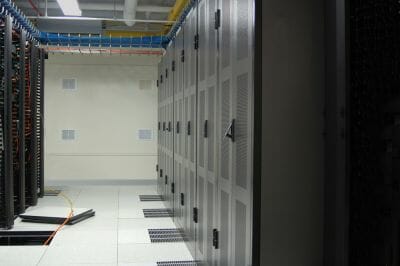4 Steps to Reducing Bypass Airflow9 min read

In a recent post, we discussed how bypass airflow directly impacts your data center’s bottom line. So it’s a well-known fact that by reducing it, you can see many benefits such as increased cooling unit efficiency and capacity, reduced operating expenses, and improved IT equipment reliability. The question is, how do you effectively reduce bypass airflow?
A common misconception is that managing the openings of a raised floor, or even installing full containment solutions, will eliminate bypass airflow. The truth is that while these solutions solve intake air temperature problems, and may reduce operating costs of IT cooling fans, the volume of bypass airflow in the room remains unchanged. In fact, sealing cable openings and properly managing perforated tiles only shifts the location of bypass airflow to the cold aisle.
While airflow management is necessary to reduce bypass airflow, there are other vital steps you need to take to see the full benefits. Below we will discuss the 4 steps you need to take to effectively reduce bypass airflow.
1st Step:
Measure your computer room’s existing Cooling Capacity Factor (CCF) to get a context for opportunities to improve. If cooling units have fixed speed fans, or fans are running at full speed, then the CCF is a good indicator of the bypass airflow ratio in the room.
- CCF can be calculated by dividing the total rated cooling capacity of the running cooling units in the computer room (kW) by 110% of the IT critical load (kW). After bench marking your room’s existing CCF, you can take steps to make improvements.
- To help you get started, we have created our free Cooling Capacity Factor Calculator.
2nd Step:
Improve AFM by making the necessary changes at each of the following three levels in the proper sequence. While this is common knowledge, surprisingly few sites have done a complete job of taking care of these fundamental prerequisites. A good mnemonic for this is these three R’s (from our 4 R’s methodology), which should be carried out in this order are: Raised floor, Rack, and then Row.
- Raised floor: Manage the open area of the horizontal plane of the raised floor. Seal cable openings and manage perforated tile placement. Check the perimeter walls below the raised floor for unsealed wall or partition penetrations. Sealing these penetrations often requires fire-rated materials.
- Rack: Close all open space of the vertical plane of IT equipment intakes. Install blanking panels, seal under cabinets, and seal between mounting rails and sides of cabinets.
- Row: Fill open spaces where IT equipment cabinets are missing or where there are gaps between cabinets. In some situations when cabinet densities are high enough or the highest possible efficiency is desired, hot or cold aisle containment may be required, but should not be considered until all AFM fundamentals have been addressed.
3rd Step:
Next, is the 4th R – Room: Changes at this level are required to affect operating costs and the volume of bypass airflow in the room. This is done by changing the cooling infrastructure in one or more of the following ways:
- Raise cooling unit return air temperature set points. Raise set points as high as possible without exceeding the IT equipment intake air temperature maximum.
- Turn off cooling units or reduce fan speeds for units with variable frequency drives (VFD) or install VFDs.
4th Step:
Lastly, repeat the process above to ensure your cooling infrastructure is optimized. (AFM improvement is an ongoing process, not a single event.)
- After each adjustment to cooling unit set points or airflow volumes, it may be necessary to adjust the number and location of perforated tiles or grates to maintain IT intake temperatures as low and even as possible.
- Keep in mind that it is important to have redundant cooling units operating so that when a cooling unit fails there is sufficient running capacity to support the load.
- Also, after implementing each AFM improvement, it will likely be possible to raise cooling unit temperature set points and/or reduce fan speeds further.
Conclusion
In data centers today, there is a large amount of excess capacity, creating the challenge for operators and data center managers to quantify bypass airflow and capacity issues at their sites. Consequently, the common misconception is that by sealing cable openings and properly managing perforated tiles, the amount of bypass airflow is reduced. This is not true. Although AFM solutions are necessary enhancements, in order to realize greater financial benefits from improving cooling capacity, changes need to be made in the cooling infrastructure.
If we think of bypass airflow as any cooling airflow volume greater than IT equipment airflow volume (rather than just as “leaks” or “holes”) there is a great opportunity to quantify, understand, and improve cooling infrastructure and reduce operating expenses. This is true regardless of the configuration of the room, including full aisle containment. Considering bypass airflow from this broader room level introduces a perspective that brings more financial benefits and savings opportunities easily within grasp.

Airflow Management Awareness Month
Free Informative webinars every Tuesday in June.
0 Comments